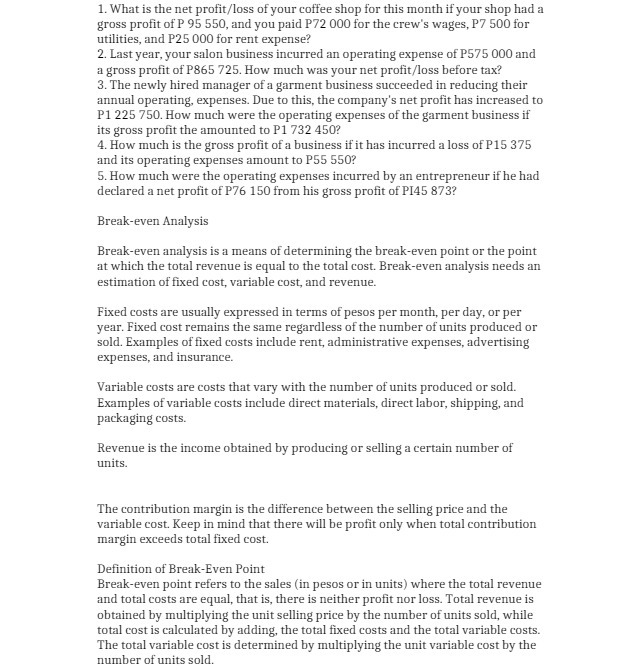1. What is the net profit/loss of your coffee shop for this month if your shop had a gross profit of P 95 550, and you paid P72 000 for the crew's wages, P7 500 for utilities, and P25 000 for rent expense? 2. Last year, your salon business incurred an operating expense of P575 000 and a gross profit of P865 725. How much was your net profit/loss before tax? 3. The newly hired manager of a garment business succeeded in reducing their annual operating, expenses. Due to this, the company's net profit has increased to P1 225 750. How much were the operating expenses of the garment business if its gross profit the amounted to P1 732 450? 4. How much is the gross profit of a business if it has incurred a loss of P15 375 and its operating expenses amount to P55 550? 5. How much were the operating expenses incurred by an entrepreneur if he had declared a net profit of P76 150 from his gross profit of PI45 873? Break-even Analysis Break-even analysis is a means of determining the break-even point or the point at which the total revenue is equal to the total cost. Break-even analysis needs an estimation of fixed cost, variable cost, and revenue. Fixed costs are usually expressed in terms of pesos per month, per day, or per year. Fixed cost remains the same regardless of the number of units produced or sold. Examples of fixed costs include rent, administrative expenses, advertising expenses, and insurance. Variable costs are costs that vary with the number of units produced or sold. Examples of variable costs include direct materials, direct labor, shipping, and packaging costs. Revenue is the income obtained by producing or selling a certain number of units. The contribution margin is the difference between the selling price and the variable cost. Keep in mind that there will be profit only when total contribution margin exceeds total fixed cost. Definition of Break-Even Point Break-even point refers to the sales (in pesos or in units) where the total revenue and total costs are equal, that is, there is neither profit nor loss. Total revenue is obtained by multiplying the unit selling price by the number of units sold, while total cost is calculated by adding, the total fixed costs and the total variable costs. The total variable cost is determined by multiplying the unit variable cost by the number of units sold







